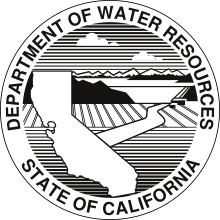California Department of Water Resources

Seal of the California Department of Water Resources
|
|
| Agency overview | |
|---|---|
| Formed | 1956 |
| Preceding agencies |
|
| Headquarters | 1416 9th Street, Sacramento, California |
| Agency executive |
|
| Parent agency | California Natural Resources Agency |
| Website | http://www.water.ca.gov/ |
The California Department of Water Resources (DWR), is part of the California Natural Resources Agency. The Department of Water Resources is responsible for the State of California's management and regulation of water usage. The department was created in 1956 by Governor Goodwin Knight following severe flooding across Northern California in 1955, combining the Division of Water Resources of the Department of Public Works with the State Engineer's Office, the Water Project Authority, and the State Water Resources Board. It has its headquarters in Sacramento.
California recognizes many types of water rights. These rights have developed with the state over time. Prior to the Treaty of Guadalupe Hidalgo, signed in 1848, California was part of Mexico. Riparian rights were the most prevalent type of water right. Under riparian rights, which have their origins in Roman law, a landowner can use water flowing by his property for use on his property. However, the Mexican Government also provided for agricultural pueblos, by granting water on the public domain for these pueblos. When California became part of the United States, the United States agreed to recognize existing law. Pueblo rights were the only vested water rights at the time. Pueblo rights provided that Spanish and Mexican pueblos were entitled to the paramount beneficial use of all needed naturally occurring water from the entire watershed of a stream flowing through the pueblo.
When gold was discovered in 1848, immigrants from all over the world came to California. During the California Gold Rush, gold miners, who were not generally land owners, would divert large quantities of water from rivers and streams for hydraulic mining. Local custom dictated how water was shared in mining camps, but in general, the miners followed the same practice in allocating water as they did in staking their mineral claims. In its earliest form, an appropriative water right was created simply by taking water and putting it to beneficial use. However, to "state a claim" miners would often post a notice to others that they were taking and using water. Soon after California became a U.S. state in 1850, the first session of the California State Legislature immediately adopted laws to deal with the state's water. This included the adoption of the English common law system, which also included the doctrine of riparian rights, although this system was better suited to the water-rich eastern United States. Shortly thereafter, Californian courts recognized appropriative water rights.
...
Wikipedia
